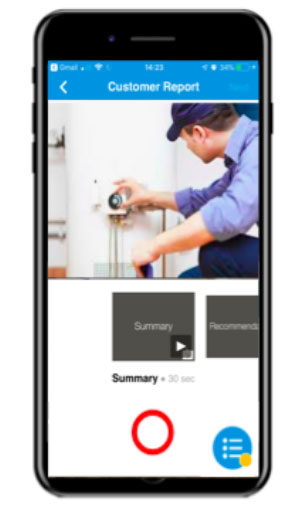Blog
3 Mar 2019
We sat down with Jennifer Cheetham Shaw, Technology & Innovation Lead for Field Operations at Centrica, to understand how she and her team make innovation projects stick and to pick up some practical tips on driving success.
The difference between digital teams and innovation teams is that one needs to deliver and the other to fail fast. This requires two very different skill sets. What are your thoughts on that?

That couldn’t be truer of what we experience as an innovation team in a large company like Centrica. Some people think we should deliver most of what we test in a proof of concept; there will always be elements of what we do that doesn't succeed, but we will have learnt something from it. It's about establishing what does and doesn't work, knowing what we need and don’t need, and is there a gap for it in the business.
We get challenged on why are we doing certain things. What's the need for our engineers? Or what's the need for our customers? Customers rarely ask for innovation. An initiative could arise and be something they don't even know they want yet. vyn is a good example of this. Customers aren’t telling us they need video notes. But my belief is that we should be forging ahead in this area. As consumers, we interact with videos more and more every day. We must see how video can be applied to the business for the future. We can’t wait for our customers to tell us they need video - by that time, it’s too late.
A lot of the initiatives we look at can seem too new for the business, for example we might try things like virtual reality, or interactive video calling. The brilliant stuff that people get straight away, is what people have asked for. We have the difficult job of identifying the needs that people haven't even asked for yet.
Where do the ideas come from?

Quite often, an initiative can be born out of a great idea from somebody within the business, but sometimes it may not have come directly from them - it could be driven by external influences. If customers aren't asking for it, it's hard to get people onboard, get their buy-in and to take them on the journey with you. To ensure a successful proof of concept, we need to prove what are we doing and why we are doing it - we have to show them how it applies to their world.
Can you explain this in the context of vyn?

I think it was a unique one, in the sense that the initial proof of concept came from me being a customer. I was the customer in the story. I was watching the engineers struggling with a problem. They would fix something temporarily and it would re-occur - every time they came back, they had to start all over again. I reached out to my bosses to talk about what we could do to help our engineers share information quicker - show more information in an easier way.
And, then the other trigger came when I received a video after my car had been in the garage. So, it was an idea from my own experience. That's when I was put in touch with Kapil and the team and I wanted to give vyn a try, because it was different.
Engineers were already recording problems to troubleshoot with colleagues, but I realised that vyn could provide a structured approach for recording and sharing with the end customer. And we’ve had some great feedback on vyn. On the whole, I’ve enjoyed the experience so much and that's why I feel that it deserves the attention from the right people.
Can you share how you got started?
Initially, we reached out to those who want to be part of innovation projects. You'll always find such people in pockets across the business - teams that are interested in new technology, who love to be involved in something that enhances their day jobs. It's great to lean on those technically-minded people who take an active interest - harness their creativity and bounce ideas off them. Then they can champion the project in the business and encourage their colleagues who may be more hesitant.
I see. So, it's important to involve people with different profiles, including those who are sceptical?
Yes, that's a true test. When you have people who are engaged and excited about something, they will give anything a try. But you then need the people who wouldn't necessarily come to you or get involved so freely, to get to the next stage. My team and I don't really mean a lot to the engineers out there, whereas their colleagues, their managers and the people they work with mean more to them and so it means more coming from them.
What else do you need to think of?
You need to think about how this piece of innovation fits in with the strategy for the business, the people, culture and the direction the business is moving in. You need to be able to articulate what you have seen to be relevant for the future of the business. Quite often, it’s about being able to create a compelling picture of how it fits. Also, how will the innovation improve on existing strategy and does it add value?
Does having to fit within the strategy of the business restrain you from the kind of innovations you can try?
Not for giving something a try, no. The strategy should never restrict you from trying something new. However, it may restrict you from launching something new depending on what else is going on at the time. If something is a really good idea and that has value for the business, we must make it relatable. Not necessarily to what's going on right now, but to what could be happening in the future. It comes back to creating the vision and painting a picture; envisaging the type of company or organisation we want to be in two or three years time.
How do you spread the word about the value of an innovation project across the company?
I think by looking across your organisation and at those who might be influencers, not just the end users but mid senior management, senior leaders. It might be change managers, might be process owners, might be digital. One of the best ways you can create momentum for a new project is to talk with lots of different people and slowly start to see who is really interested.
In this context, would you err on the side of more rather than less?

We like to share with lots of relevant people just to try and and create that engagement. You're not going to them with the end result - you are going to them because you want to share and give them an opportunity to see and hear what's going on. We need their feedback on the idea or concept and how it might be relevant for them in their business area.
What steps do you need to take to validate an innovation project and progress it?
You need to think of processes and how things will fit. You’ve got to be realistic. Keep things simple and engaging. You can't expect people to give a large part of their day for an innovation that you want to try. Be passionate when you're delivering the concept. You've got to be able to sit or stand in the room, or get on a call and sound excited about it yourself, otherwise it's not going to take off. Quite often, there's too much change going on, so trying to squeeze in another new thing is hard. At other times, it can be a welcome break from everyday tasks!

When you talk about innovation and proof of concept, we tell the business that this isn't something that has already been decided and we are giving them something to try. Quite often, we’ve been able to mould an idea and help adjust the product or service based on direct feedback from our employees. We encourage them to be honest and in return, we are honest with them. We let them know that this is not a given, but we are seeking their help to potentially shape the offering. When you’re making a change, it means you’ve already validated the benefits, you're creating the change environment and getting it ready for the business to use.
Any tips on how you influence senior stakeholders in the business to share your belief in an innovation, especially budget owners?
Having led a successful proof of concept and seen the benefit, engagement and buy-in first hand, start sharing that with people who have come with you on the innovation journey. Find out who they report to, what part of the organisation they fit into and share what they have achieved - feed that excitement up the chain!
Moving on... what would you say is the ideal profile of an innovation leader?
I think you’ve got to be passionate about trying something new, about being creative with ideas and able to speak confidently to all people at all levels. We communicate with everybody from senior leaders to engineers and field operatives to customers and vendors.
{tweetme} "If you can't paint a picture of how it will impact customers or how it can create a movement or a change and get people to listen, you won’t succeed."{/tweetme}
You’ve got to be a good storyteller and paint a picture for people. In an innovation setting, if you can't paint a picture of how it will impact customers or how it can create a movement or a change and get people to listen, you won’t succeed. If you are engaging - it can take you a long way.
Any particular challenges to be aware of in a role like yours?
Plenty! I am constantly learning. For me, it’s a benefit to have a background in different functional areas - customer experience, change management, project management and operational experience. It means I can relate to the change that our end users experience and how it will impact them. Do you know what life is like for your end users? For people with a technical background, they might understand the technology but not necessarily the important role the end users play. You've got to make people feel excited and make people feel listened to, as you're going to need their help to progress and share the story. If you don't understand their world, then you might not be able to to take them on the journey with you.
Any final thoughts or advice on making innovation projects successful?
{tweetme}"The numbers will get people's attention, but the story will make it memorable for the right people!"{/tweetme}
You've got to make it relevant to the business - create the vision and the picture, make it exciting and different so that it's a nice conversation to have. There are other change projects which are not as exciting, with vyn there's a personal and human element. The numbers will get people's attention, but the story will make it memorable for the right people!
Thank you for reading.
--
Follow vyn on LinkedIn or Twitter to get more insights like this, or sign up to our newsletter.

